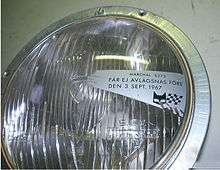Dagen H



Dagen H (H day), today mostly called "Högertrafikomläggningen" ("The right-hand traffic diversion"), was the day, 3 September 1967, on which traffic in Sweden switched from driving on the left-hand side of the road to the right. The "H" stands for "Högertrafik", the Swedish word for "right traffic".
Trams in central Stockholm, in Helsingborg and most lines in Malmö were withdrawn and replaced by buses, and over one thousand new buses were purchased with doors on the right-hand side. Some 8,000 older buses were retrofitted to provide doors on both sides, while Gothenburg and Malmö exported their right-hand drive (RHD) buses to Pakistan and Kenya.[1] The modification of buses, paid by the state, was the largest cost of the change. In Gothenburg and Norrköping, and in two Stockholm suburbs, tram networks continued to operate.


Background
There were various major arguments for the change:
- All Sweden's immediate neighbours drove on the right (including Norway and Finland, with which Sweden has land borders) with 5 million vehicles crossing those borders annually.[2]
- Approximately 90 per cent of Swedes drove left-hand drive (LHD) vehicles.[2] This led to many head-on collisions when passing on narrow two-lane highways, which were common in Sweden because of its low population density and traffic levels.[3]
However, the change was widely unpopular; in a 1955 referendum, 83 percent voted to keep driving on the left. Nevertheless, on May 10, 1963, the Riksdag approved the introduction of right hand traffic in 1967, as the number of cars on the road had tripled from 500 000 to 1.5 million, and was expected to reach 2.8 million by 1975.[4] A body known as Statens Högertrafikkommission (HTK) ("the state right-hand traffic commission") was established to oversee the changeover.[5] It also began implementing a four-year education program, with the advice of psychologists.[3]
The campaign included displaying the Dagen H logo on various commemorative items, including milk cartons and underwear.[3][6] Swedish television held a contest for songs about the change; the winning entry was "Håll dig till höger, Svensson" ('Keep to the right, Svensson') by The Telstars.[7]
As Dagen H neared, every intersection was equipped with an extra set of poles and traffic signals wrapped in black plastic. Workers roamed the streets early in the morning on Dagen H to remove the plastic. Similarly, a parallel set of lines were painted on the roads with white paint, then covered with black tape. Before Dagen H, Swedish roads had used yellow lines.
The switch
On Dagen H, Sunday, 3 September, all non-essential traffic was banned from the roads from 01:00 to 06:00. Any vehicles on the roads during that time had to follow special rules. All vehicles had to come to a complete stop at 04:50, then carefully change to the right-hand side of the road and stop again before being allowed to proceed at 05:00. In Stockholm and Malmö, however, the ban was longer — from 10:00 on Saturday until 15:00 on Sunday — to allow work crews to reconfigure intersections.[8] Certain other towns also saw an extended ban, from 15:00 on Saturday until 15:00 on Sunday.
One-way streets presented unique problems. Bus stops had to be constructed on the other side of the street. Intersections had to be reshaped to allow traffic to merge.
In order to avoid blinding the oncoming drivers, all Swedish vehicles had to have their original left-hand-traffic headlamps replaced with right-hand units. One of the reasons the Riksdag pushed ahead with Dagen H despite public unpopularity was that most vehicles in Sweden at the time used inexpensive, standardized round headlamps, but the trend towards more expensive model-specific headlamps had begun in Continental Europe and was expected to spread through most other parts of the world. Further delay in changing over from left- to right-hand traffic would have greatly increased the cost burden to vehicle owners.
Results
On the day of the change, only 157 minor accidents were reported, of which only 32 involved personal injuries, with only a handful serious.[9] On the Monday following Dagen H, there were 125 reported traffic accidents, compared to a range of 130 to 198 for previous Mondays, none of them fatal. Experts suggested that changing to driving on the right reduced accidents while overtaking, as people already drove left-hand drive vehicles, thereby having a better view of the road ahead; additionally, the change made a marked surge in perceived risk that exceeded the target level and thus was followed by very cautious behaviour that caused a major decrease in road fatalities. Indeed, fatal car-to-car and car-to-pedestrian accidents dropped sharply as a result, and the number of motor insurance claims went down by 40%.
These initial improvements did not last, however. The number of motor insurance claims returned to 'normal' over the next six weeks and, by 1969, the accident rates were back to the levels seen before the change.[10][11][12]
Additionally, many tram systems were abandoned as a result of Dagen H; only the trams in Norrköping and Gothenburg and three suburban lines in the Stockholm area (Nockebybanan and Lidingöbanan) survived.
See also
- 730 (transport)
- H-dagurinn
- Right and left hand traffic
- Switch to right hand traffic in Czechoslovakia
- Transport in Sweden
References
- ↑ Public transport was affected, 22 February 1997
- 1 2 Réalités, Issues 200-205, Société d'études et publications économiques, 1967, page 95
- 1 2 3 Switch to the Right, TIME, 15 Sep. 1967
- ↑ News from Sweden, Issues 840-858, Swedish Information Service, Swedish Consulate General, 1963, page 35
- ↑ Riksdagens protokoll, Kungl. Boktr., 1966, page 8
- ↑ "Dagen H". Retrieved 2 October 2014.
- ↑ The Telstars - Håll dig till höger, Svensson
- ↑ Sweden Makes Change-Over to Driving on Right, Glasgow Herald, 4 September 1967
- ↑ "Swedish Motorists Move To Right". Montreal Gazette. 5 September 1967.
- ↑ Adams, John (1985). Risk and Freedom: Record of Road Safety Regulation. Brefi Press. ISBN 978-0948537059.
- ↑ "Dagen H: The day Sweden switched sides of the road". Washington Post. February 17, 2012. Retrieved 2 October 2014.
- ↑ Behavioural Adaptation and Road Safety: Theory, Evidence and Action. CRC Press. p. 67. ISBN 978-1-4398-5667-3.
External links
| Wikimedia Commons has media related to Dagen H. |
- Television coverage of changeover, Sveriges Television
- The Day Sweden Turned Right, BBC World Service, 2 September, 2016